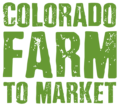Find out if you are covered by the FDA’s Food Safety Modernization Act (FSMA) Produce Safety Rule at www.coproducesafety.org.
Definition:
- Tubers: Tubers are various types of modified plant structures that are enlarged to store nutrients. They are used by plants to survive the winter or dry months and provide energy and nutrients for regrowth during the next growing season and they are a means of asexual reproduction. The most common edible tuber is the potato.
- Bulbs: A bulb is a short stem with fleshy leaves or leaf bases. The leaves often function as food storage organs during dormancy. Common edible bulbs include garlic and onion.
- Root Vegetables: Root vegetables are generally storage organs, enlarged to store energy in the form of carbohydrates. Root vegetables include radish, carrot, beet, and parsnip.
- Tomato: The tomato is a savory, typically red, edible fruit, from the plant Solanum lycopersicum.
- Pepper: Peppers are tender, warm-season vegetables. Many varieties exist, but two main types, sweet peppers and hot peppers, are commonly eaten.
- Squash: Squashes generally refer to species of the genus Cucurbita native to Mexico and Central America. Squashes may be classified as summer or winter.
- Corn: Also called maize, corn is a popular warm season vegetable and grain crop.
Food Safety: For more information on best practices for safe production, harvesting, and transporting to market, please see the Good Agricultural Practices (GAPs) section. Foodborne illness outbreaks have been associated with whole vegetables, such as tomatoes and peppers, but steps can be taken to reduce the risk of contamination through the use of GAPs. Food safety issues may also arise if the soil is contaminated by manure containing harmful pathogens or irrigated with contaminated water sources. Because the edible portions of tubers, bulbs, and root vegetables are in direct contact with the soil, minimizing potential sources of microbial contamination pre- and post-harvest is essential. Refer to the related links listed below for more information regarding commodity specific guidelines.
If you are planning to freeze or can vegetables, please refer to the fact sheets (see below related links) for more information on processing or preserving vegetables and food safety.
Distribution Method | Collapse All)
You are selling your product at a farmers’ market, CSA, roadside stand, or other direct to consumer outlet
Weights and Measures: If you are selling your product by weight, you must follow the Colorado weights and measures requirements. Product might also be sold by count or bunch, refer to the fruits and vegetables section of weights and measures for guidelines.
You are selling your product to a store, restaurant, food cart, K-12 school, university, hospital, or other retail food establishment
Value Added Products: Frozen, canned, dried, or other prepared food items.
Related Links:
- Colorado State University: Produce Fact Sheets
- Good Agricultural Practices for Colorado Producers
- FDA Guide to Minimizing Microbial Food Safety Hazards of Tomatoes
- Colorado State University Extension: Canning Tomatoes and Tomato Products
- Colorado State University Extension: Making Pickled Peppers
- Colorado State University Extension: Cucumbers, Pumpkins, Squash, and Melons
- Colorado State University Extension: Freezing Vegetables
- Colorado State University Extension: Canning Vegetables
- Colorado State University Extension: Drying Vegetables
- Colorado Potato Growers and Shippers
